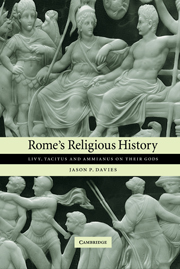3 - Gods and men in Livy
Published online by Cambridge University Press: 21 December 2009
Summary
Introduction
The discussion thus far has focussed on re-examining Livy's presentation and has argued for a more nuanced approach in reading his religious material. We can now begin analysis of his religious material in earnest. Much of it will lend itself with ease to the kinds of issues raised in the introduction. As a working principle, coherence and intelligibility is maximised, not least as a corrective to previous discussions. This is not to imply that incoherence is absent, or should be explained away; all cultural systems are notoriously contradictory in manifold respects. But the very observation of incoherence relies upon the assumption of a meaningful structure of concepts that have a relationship to one another: much of this system may not be explicit at any given moment. The following account therefore represents what is fundamentally an experimental analysis of the religious system deployed by Livy. No other authors are taken into account – which can be treated as either a strength or a weakness; no essay could attempt to incorporate all sources on these topics in more than a few authors at best, and those that did would run the risk of failing to appreciate the various contexts of the material. This analysis is therefore limited, and thereby all the more precise. It is structured along lines that are familiar to the scholar of Roman literature, though it might be said that the end result is a subversion of that structure. In that it is intended to be a reasonably full answer to many of the criticisms of typically problematic areas, it is more usefully considered a starting point than a final result in itself.
- Type
- Chapter
- Information
- Rome's Religious HistoryLivy, Tacitus and Ammianus on their Gods, pp. 86 - 142Publisher: Cambridge University PressPrint publication year: 2005

